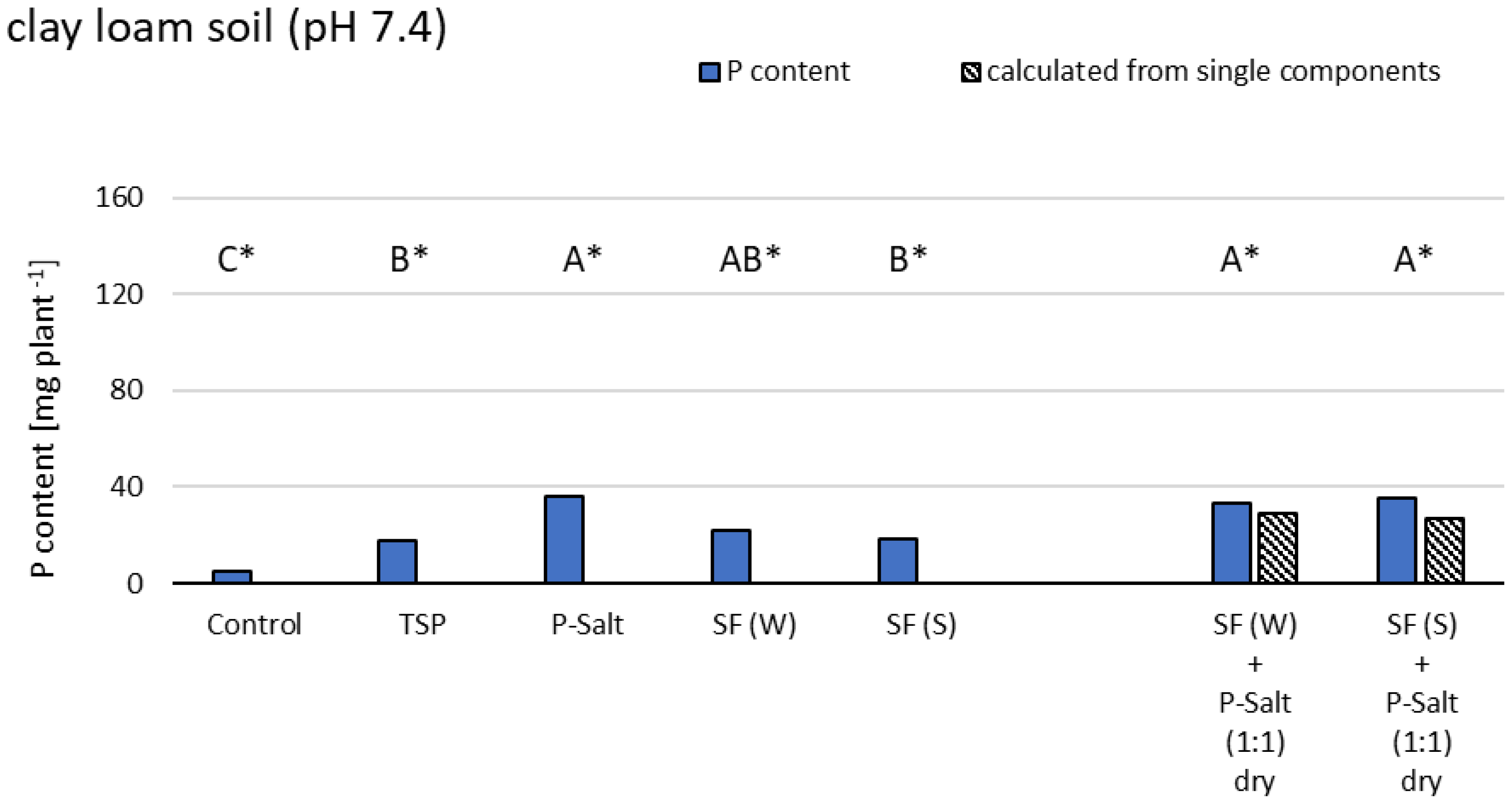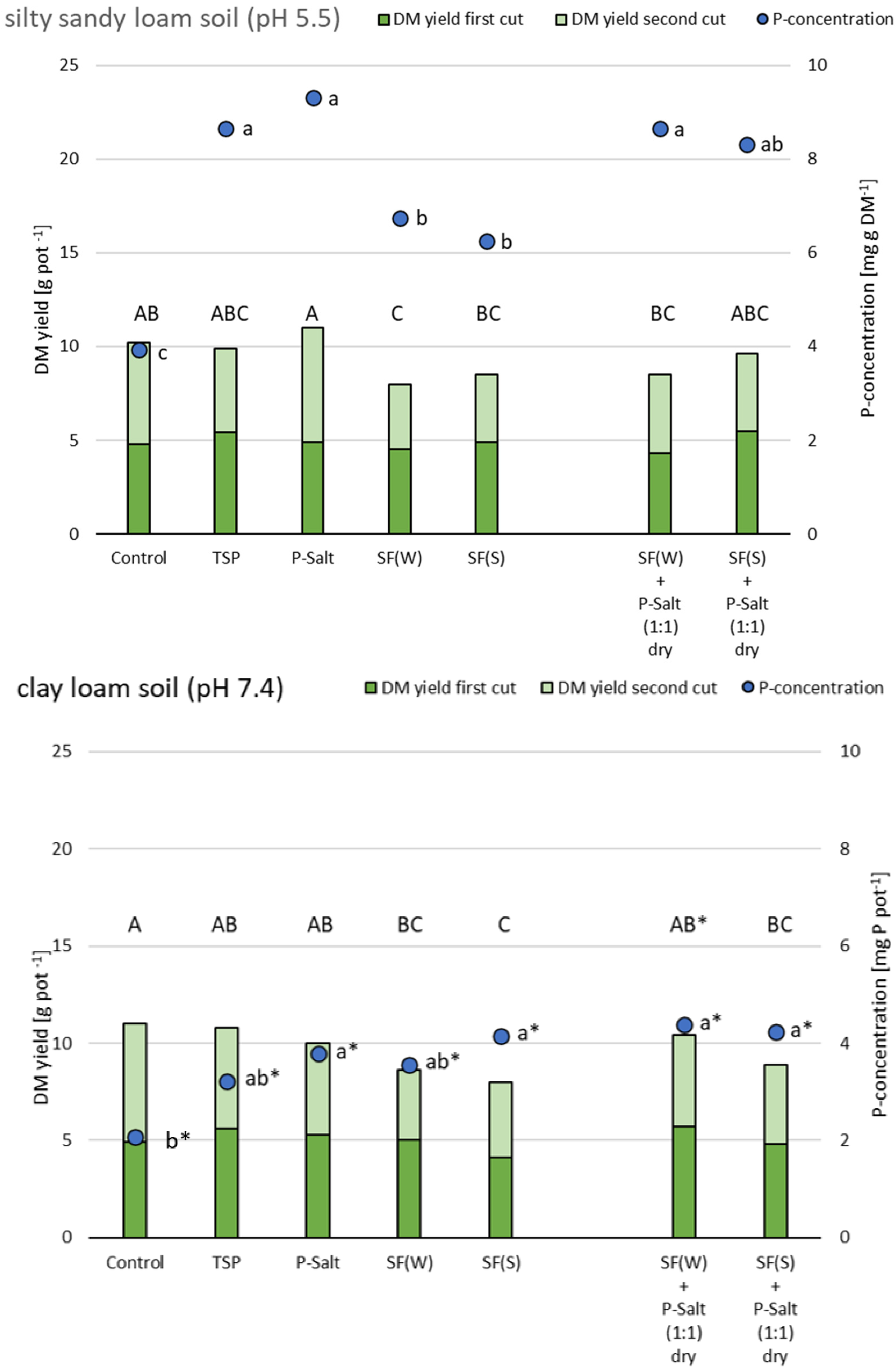Efficiency of Phosphorus Fertilizers Derived from Recycled Biogas Digestate as Applied to Maize and Ryegrass in Soils with Different pH
Abstract
:1. Introduction
- Compared to a mineral P fertilizer (TSP), fractions recycled from biogas digestates can be effective P fertilizers over a range of soils differing in pH conditions (5.5 and 7.4), with advantages in acidic soils.
- Combined treatments (P-Salt + SF W/S) result in a higher P bioavailability, with synergistic effects, compared to the single application in both soils.
- Ryegrass as a widespread weed does not benefit from recycled P fertilizers with regard to biomass production, and thus, its use does not require changes in weed control.
- Ryegrass cultivation as an option for soil remediation after use of excess mineral P can also be used after application of recycled P fertilizers.
2. Materials and Methods
2.1. Recycled P Fertilizers
2.2. Soil Characteristics
2.3. Soil Sampling and Analysis of P, K, Mg and pH
2.4. Experimental Details
2.5. Maize and Ryegrass Harvest and P Analysis
2.6. Evaluation of Synergistic Effects
2.7. Statistical Analysis
3. Results
3.1. Effect of P Fertilizers on Maize Biomass Yield and Plant P Concentration
3.2. Effect of P Fertilizers on Plant Nutrient Content in Maize
3.3. Effect of P Fertilizers on Ryegrass Biomass Yield and Plant P Concentration
3.4. Effect of P Fertilizers on Plant Nutrient Content in Ryegrass
3.5. Effect of P Fertilizers on Plant Available P (CAL-P) in Soil
4. Discussion
4.1. Effects of P Fertilizers on Maize Biomass Yield and P Uptake
4.2. Influence of P Fertilizers on Ryegrass Biomass Yield and P Uptake
4.3. CAL-P in Soil
5. Conclusions
Author Contributions
Funding
Institutional Review Board Statement
Informed Consent Statement
Data Availability Statement
Acknowledgments
Conflicts of Interest
References
- Garg, S.; Bahl, G.S. Phosphorus availability to maize influenced by organic manures and fertilizer P associated phosphatase activity in soils. Bioresour. Technol. 2008, 99, 5773–5777. [Google Scholar] [CrossRef] [PubMed]
- Barrow, N.J.; Debnath, A. Effect of phosphate status on the sorption and desorption properties of some soils of northern India. Plant Soil 2014, 378, 383–395. [Google Scholar] [CrossRef]
- Müller, T.; Zhang, F. Maize-based food-feed-energy systems under limited phosphate resources. Front. Agric. Sci. Eng. 2019, 6, 313–320. [Google Scholar] [CrossRef] [Green Version]
- Shen, J.; Yuan, L.; Zhang, J.; Li, H.; Bai, Z.; Chen, X.; Zhang, W.; Zhang, F. Phosphorus Dynamics: From Soil to Plant. Plant Physiol. 2011, 156, 997–1005. [Google Scholar] [CrossRef] [PubMed] [Green Version]
- De Bolle, S.; De Neve, S.; Hofmann, G. Rapid redistribution of P to deeper soil layers in P saturated acid sandy soils. Soil Use Manag. 2013, 29, 76–82. [Google Scholar] [CrossRef]
- Djojic, F.; Bergström, L.; Grant, C. Phosphorus management in balanced agricultural systems. Soil Use Manag. 2005, 21, 94–101. [Google Scholar] [CrossRef]
- Ohtake, H.; Tsuneda, S. Phosphorus Recovery and Recycling; Springer: Singapore, 2019. [Google Scholar]
- U.S. Geological Survey. Mineral Commodity Summaries; U.S. Department of the Interior, U.S. Geological Survey: Reston, VA, USA, 2021.
- Lou, H.; Zhao, C.; Yang, S.; Shi, L.; Wang, Y.; Ren, X.; Bai, J. Quantitative evaluation of legacy phosphorus and its spatial distribution. J. Environ. Manag. 2018, 211, 296–305. [Google Scholar] [CrossRef]
- Krüger, O.; Adam, C. Phosphorus in recycling fertilizers—Analytical challenges. Environ. Res. 2017, 155, 353–358. [Google Scholar] [CrossRef]
- European Commission (2014) COM 1-214-297-EN F1-1 Communication from the Commission to the European Parliament, the Council, the European Economic and Social Committee and the Committee of the Regions: On the Review of the List of Critical Raw Materials for the EU and the Implementation of the Raw Materials Initiative. {SWD(2014) 171 Final}. Available online: https://eur-lex.europa.eu/legal-content/EN/TXT/PDF/?uri=CELEX:52014DC0297&from=CS (accessed on 5 January 2022).
- European Commission (2017) Communication from the Commission to the European Parliament, the Council, the European Economic and Social Committee and the Committee of the Regions on the 2017 List of Critical Raw Materials for the EU. {COM(2017) 490 Final}. Available online: https://ec.europa.eu/transparency/documents-register/detail?ref=COM(2017)490&lang=en (accessed on 5 January 2022).
- Eichler-Löbermann, B.; Köhne, S.; Köppen, D. Effect of organic, inorganic, and combined organic and inorganic P fertilization on plant P uptake and soil P pools. J. Plant Nutr. Soil Sci. 2007, 170, 623–628. [Google Scholar] [CrossRef]
- Kratz, S.; Vogel, C.; Adam, C. Agronomic performance of P recycling fertilizers and methods to predict it: A review. Nutr. Cycl. Agroecosyst. 2019, 115, 1–39. [Google Scholar] [CrossRef]
- Talboys, P.J.; Heppell, J.; Roose, T.; Healey, J.R.; Jones, D.L.; Withers, P.J.A. Struvite: A slow-release fertiliser for sustainable phosphorus management? Plant Soil 2016, 401, 109–123. [Google Scholar] [CrossRef] [PubMed] [Green Version]
- EBA. Statistical Report; European Biogas Association: Brussels, Belgium, 2018. [Google Scholar]
- Produzierendes Gewerbe, Düngemittelversorgung, Wirtschaftsjahr 2019/2020. Statistisches Bundesamt (Destatis). 2020. Available online: https://www.destatis.de/DE/Themen/Branchen-Unternehmen/Industrie-Verarbeitendes-Gewerbe/Publikationen/Downloads-Fachstatistiken/duengemittelversorgung-jahr-2040820207004.pdf?__blob=publicationFile (accessed on 25 September 2021).
- Alburquerque, J.A.; de la Fuente, C.; Campoy, M.; Carrasco, L.; Najera, I.; Baixauli, C.; Caravaca, F.; Roldan, A.; Cegarra, J.; Bernal, M.P. Agrucultural use of digestate for horticultural crop production and improvement of soil properties. Eur. J. Agron. 2012, 43, 119–128. [Google Scholar] [CrossRef]
- Möller, K.; Müller, T. Effects of anaerobic digestion on digestate nutrient availability and crop growth: A review. Eng. Life Sci. 2012, 12, 242–257. [Google Scholar] [CrossRef]
- Romero-Güiza, M.S.; Mata-Alvarez, J.; Chimenos Rivera, J.M.; Astals Garcia, S. Nutrient recovery technologies for anaerobic digestion systems: An overview. Rev. ION 2016, 29, 7–26. [Google Scholar] [CrossRef] [Green Version]
- Kahiluoto, H.; Kuisma, M.; Ketoja, E.; Salo, T.; Heikkinen, J. Phosphorus in manure and sewage sludge more recyclable than in soluble inorganic fertilizer. Environ. Sci. Technol. 2015, 49, 2115–2122. [Google Scholar] [CrossRef] [Green Version]
- Lambers, H.; Finnegan, P.M.; Lalibertè, E.; Pearse, S.J.; Ryan, M.H.; Shane, M.W.; Veneklaas, E.J. Phosphorus nutrition of Proteaceae in severely ohosphorus-impoverished soils: Are there lessons to be learned for future? Plant Physiol. 2011, 156, 1058–1066. [Google Scholar] [CrossRef] [Green Version]
- Bach, I.-M.; Essich, L.; Müller, T. Efficiency of recycled biogas digestates as phosphorus fertilizers for maize. Agriculture 2021, 11, 553. [Google Scholar] [CrossRef]
- Ehmann, A.; Bach, I.-M.; Bilbao, J.; Lewandowski, I.; Müller, T. Phosphate recycled from semi-liquid manure and digestate are suitable alternative fertilizers for ornamentals. Sci. Hortic. 2018, 243, 440–450. [Google Scholar] [CrossRef]
- Penn, C.J.; Camberato, J.J. A critical review on soil chemical processes that control how soil pH affects phosphorus availability to plants. Agriculture 2019, 9, 120. [Google Scholar] [CrossRef] [Green Version]
- Murrmann, R.P.; Peech, M. Effect of pH on Labile and Soluble Phosphate in Soils. Soil Sci. Soc. Am. J. 1969, 33, 205–210. [Google Scholar] [CrossRef]
- Gustafsson, J.P.; Mwamila, L.B.; Kergoat, K. The pH dependence of phosphate sorption and desorption in Swedish agricultural soils. Geoderma 2012, 189, 304–311. [Google Scholar] [CrossRef] [Green Version]
- Scanlan, C.; Brennan, R.; Sarre, G.A. Effect of soil pH and crop sequence on the response of wheat (Triticum aestivum) to phosphorus fertiliser. Crop Pasture Sci. 2015, 66, 23–31. [Google Scholar] [CrossRef]
- Von Tucher, S.; Hörndl, D.; Schmidhalter, U. Interaction of soil pH and phosphorus efficacy: Long-term effects of P fertilizer and lime applications on wheat, barley, and sugar beet. Ambio 2018, 47, 41–49. [Google Scholar] [CrossRef] [PubMed] [Green Version]
- Penn, C.J.; Rutter, E.B.; Arnall, D.B.; Camberato, J.; Williams, M.; Watkins, P. A discussion on mehlich-3 phosphorus extraction from the perspective of governing chemical reactions and phases: Impact of soil pH. Agriculture 2018, 8, 106. [Google Scholar] [CrossRef] [Green Version]
- Cabeza, R.; Steingrobe, B.; Römer, W.; Claassen, N. Effectiveness of recycled P products as P fertilizers, as evaluated in pot experiments. Nutr. Cycl. Agroecosyst. 2011, 91, 173–184. [Google Scholar] [CrossRef]
- Römer, W.; Steingrobe, B. Fertilizer Effect of Phosphorus Recycling Products. Sustainability 2018, 10, 1166. [Google Scholar] [CrossRef] [Green Version]
- Ehmann, A.; Bach, I.-M.; Laopeamthong, S.; Bilbao, J.; Lewandowski, I. Can Phosphate Salts Recovered from Manure Replace Conventional Phosphate Fertilizer? Agriculture 2017, 7, 1. [Google Scholar] [CrossRef] [Green Version]
- Bilbao, J.; Frank, D.; Hirth, T. Combined Recovery of Phosphorus, Potassium and Nitrogen from Aqueous Residual Material; International Classification, Cooperative Patent Classification C01B25/45; Fraunhofer GES zur Förderung der Angewandten Forschung EV: Munich, Germany, 2015. [Google Scholar]
- Schüller, H. Die CAL-Methode, eine neue Methode zur Bestimmung des pflanzenverfügbaren Phosphates in Böden. Z. Pflanzenernähr. Düngg. Bodenk. 1969, 123, 48–63. [Google Scholar] [CrossRef]
- VDLUFA Methode A 5.1.1. pH-Wert. In Handbuch der Landwirtschaftlichen Versuchs- und Untersuchungsmethodik (VDLUFA-Methodenbuch), Bd. I Die Untersuchung von Böden; VDLUFA: Darmstadt, Germany, 1991.
- VDLUFA Methode 2.1.1. Nasschemischer Aufschluss unter Druck. In Handbuch der Landwirtschaftlichen Versuchs- und Untersuchungsmethodik (VDLUFA-Methodenbuch), Bd. VII Umweltanalytik 4. Aufl.; VDLUFA: Darmstadt, Germany, 2011.
- Lenth, R.V. emmeans: Estimated Marginal Means, aka Least-Squares Means. R Package, Version 1.5.4. 2021. Available online: https://CRAN.R-project.org/package=emmeans(accessed on 16 May 2021).
- Hothorn, T.; Bretz, F.; Westfall, P. Simultaneous Inference in General Parametric Models. Biom. J. 2008, 50, 346–363. [Google Scholar] [CrossRef] [Green Version]
- Piepho, H.-P. An Algorithm for a Letter-Based Representation of All-Pairwise Comparisons. J. Comput. Graph. Stat. 2004, 13, 456–466. [Google Scholar] [CrossRef]
- European Soil Data Centre (ESDAC). Soil pH in Europe. Map: pH in Europe. 2010. Available online: https://esdac.jrc.ec.europa.eu/content/soil-ph-europe (accessed on 25 September 2021).
- Möller, K.; Oberson, A.; Bünemann, E.K.; Cooper, J.; Friedel, J.K.; Glaesner, N.; Hörtenhuber, S.; Loes, A.K.; Mäder, P.; Meyer, G.; et al. Improved phosphorus cycling in organic farming: Navigating between constraints. Adv. Agron. 2018, 147, 159–237. [Google Scholar]
- Nanzer, S.; Oberson, A.; Berger, L.; Berset, E.; Hermann, L.; Frossard, E. The plant availability of phosphorus from thermo-chemically treated sewage sludge ashes as studied by 33P labeling techniques. Plant Soil 2014, 377, 439–456. [Google Scholar] [CrossRef] [Green Version]
- Sheil, T.S.; Wall, D.P.; Culleton, N.; Murphy, J.; Grant, J.; Lalor, S.T.J. Long-term effects of phosphorus fertilizer on soil test phosphorus, phosphorus uptake and yield of perennial ryegrass. J. Agric. Sci. 2016, 154, 1068–1081. [Google Scholar] [CrossRef]
- Burkitt, L.L.; Donaghy, D.J.; Smethurst, P.J. Low rates of phosphorus fertilizer applied strategically throughout the growing season under rain-fed conditions did not affect dry matter production of perennial ryegrass (Lolium perenne L.). Crop Pasture Sci. 2010, 61, 353–362. [Google Scholar] [CrossRef]
- Karn, J.F. Phosphorus nutrition of grazing cattle: A review. Anim. Feed Sci. Technol. 2001, 89, 133–153. [Google Scholar] [CrossRef]
- Starnes, D.L.; Padmanabhan, P.; Sahi, S.V. Effect of P sources on growth, P accumulation and activities of phytase and acid phosphatases in two cultivars of annual ryegrass (Lolium multiflorum L.). Plant Physiol. Biochem. 2008, 46, 580–589. [Google Scholar] [CrossRef]
- Wortmann, C.S.; Dobermann, A.R.; Ferguson, R.B.; Hergert, G.W.; Shapiro, C.A.; Tarkalson, D.D.; Walters, D.T. High-yielding corn response to applied phosphorus, potassium, and sulfur in Nebraska. Agron. J. 2009, 101, 546–555. [Google Scholar] [CrossRef] [Green Version]
- Rashid, M.; Iqbal, M. Effect of phosphorus fertilizer on the yield and quality of maize (Zea mays L.) fodder on clay loam soil. J. Anim. Plant Sci. 2012, 22, 199–203. [Google Scholar]
- Curtin, D.; Syers, J.K. Lime-induced changes in indices of soil phosphate availability. Soil Sci. Soc. Am. J. 2001, 65, 147–152. [Google Scholar] [CrossRef]
- Hinsinger, P. Bioavailability of soil inorganic P in the rhizosphere as affected by root-induced chemical changes: A review. Plant Soil 2001, 237, 173–195. [Google Scholar] [CrossRef]






| Start Crop | Maize (Zea mays L., var. Carolinio) 3 seeds per pot; after germination, reduction to 1 seedling per pot |
| Soil | Silty sandy loam: Texture sSL; pH (CaCl2) 5.5; nutrient status for P, K, Mg (all CAL) in mg/kg soil: 15, 100, 32 Clay loam: Texture tL; pH (CaCl2) 7.4; nutrient status for P, K, Mg (all CAL) in mg/kg soil): 26, 150, 580 |
| Additional mineral fertilization per pot (excluding P) | 200 (mg N (kg soil)−1) as NH4NO3, 200 (mg K (kg soil)−1) as K2SO4, 100 (mg Mg (kg soil)−1) as MgSO4 * 7H2O and 10 (mg Fe (kg soil)−1) Fe-Sequestren (6 %). 4 weeks after sowing: 200 (mg N (kg soil)−1) as NH4NO3 |
| Experimental Duration | Total: 50 days (Time schedule, Figure 1: 0–50 days) |
| Conditions | Ambient greenhouse conditions (University of Hohenheim, Germany, June 2017); ca. 16 h light, 8 h dark, ca. 20 °C, watering to 70% WHC with DI water (weight control every 2–3 days) |
| P fertilizer treatments: | |
| Recycled P fertilizers | All mg below refer to P equivalents per 1 kg dry soil |
| P-Salt SF(W) SF(S) | 150 mg 150 mg 150 mg |
| SF(W) + P-Salt (1:1) dry | Dry mixed (“dry”): 75 mg SF(W) mixed into the soil, directly followed by + 75 mg P-Salt mixed into the soil |
| SF(S) + P-Salt (1:1) dry | Dry mixed (“dry”): 75 mg SF(S) mixed into the soil, directly followed by + 75 mg P-Salt mixed into the soil |
| Control treatments: Triple superphosphate (TSP) Negative control | Positive Reference; 150 mg DI water |
| Ryegrass cultivation in the remaining pots (same soils and treatments, same greenhouse conditions): | |
| Following crop | Perennial ryegrass (Lolium perenne L., cv. Arvicola) 5 g seeds per pot |
| Experimental Duration | 84 days from seeding to harvest (Time schedule, Figure 1: 50–134 days) |
| Harvest (grass cuts) | First cut: 56 days after sowing Second cut: 84 days after sowing |
| Fertilization | No additional mineral or recycled P fertilization |
| Irrigation | Watering to 70% WHC with DI water (weight control every 2–3 days) |
| P Sources | CAL-P after Ryegrass Harvest | CAL-P after Ryegrass Harvest |
|---|---|---|
| Silty Sandy Loam Soil [mg kg−1] | Clay Loam Soil [mg kg−1] | |
| Control | 19 D | 19 C |
| TSP | 42 C | 38 AB |
| P-Salt | 81 A | 44 AB * |
| SF(W) | 50 BC | 44 AB |
| SF(S) | 43 C | 33 B * |
| SF(W) + P-Salt (1:1) dry | 61 B | 43 AB * |
| SF(S) + P-Salt (1:1) dry | 67 AB | 48 A * |
Publisher’s Note: MDPI stays neutral with regard to jurisdictional claims in published maps and institutional affiliations. |
© 2022 by the authors. Licensee MDPI, Basel, Switzerland. This article is an open access article distributed under the terms and conditions of the Creative Commons Attribution (CC BY) license (https://creativecommons.org/licenses/by/4.0/).
Share and Cite
Bach, I.-M.; Essich, L.; Bauerle, A.; Müller, T. Efficiency of Phosphorus Fertilizers Derived from Recycled Biogas Digestate as Applied to Maize and Ryegrass in Soils with Different pH. Agriculture 2022, 12, 325. https://doi.org/10.3390/agriculture12030325
Bach I-M, Essich L, Bauerle A, Müller T. Efficiency of Phosphorus Fertilizers Derived from Recycled Biogas Digestate as Applied to Maize and Ryegrass in Soils with Different pH. Agriculture. 2022; 12(3):325. https://doi.org/10.3390/agriculture12030325
Chicago/Turabian StyleBach, Inga-Mareike, Lisa Essich, Andrea Bauerle, and Torsten Müller. 2022. "Efficiency of Phosphorus Fertilizers Derived from Recycled Biogas Digestate as Applied to Maize and Ryegrass in Soils with Different pH" Agriculture 12, no. 3: 325. https://doi.org/10.3390/agriculture12030325
APA StyleBach, I.-M., Essich, L., Bauerle, A., & Müller, T. (2022). Efficiency of Phosphorus Fertilizers Derived from Recycled Biogas Digestate as Applied to Maize and Ryegrass in Soils with Different pH. Agriculture, 12(3), 325. https://doi.org/10.3390/agriculture12030325






